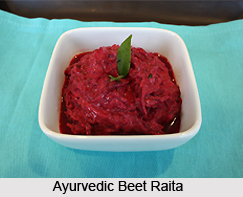 Ayurvedic beet raita is nutritious and ensures various health benefits if it is taken regularly on moderation. The basic ingredients of Ayurvedic beet raita are beets, yogurt, mustard seeds and curry leaves to name a few. The spices and other ingredients help yogurt to make it easy to digest. Beets are good for purifying the blood and also work as tonic. It is also good for the skin and thus Ayurvedic beet raita is quite a beneficiary diet. It can be served as a side dish or sauce or dip to team up with light meal or even with snack items like flat breads, kebabs, cutlets. It is easy to prepare and can be made at home.
Ayurvedic beet raita is nutritious and ensures various health benefits if it is taken regularly on moderation. The basic ingredients of Ayurvedic beet raita are beets, yogurt, mustard seeds and curry leaves to name a few. The spices and other ingredients help yogurt to make it easy to digest. Beets are good for purifying the blood and also work as tonic. It is also good for the skin and thus Ayurvedic beet raita is quite a beneficiary diet. It can be served as a side dish or sauce or dip to team up with light meal or even with snack items like flat breads, kebabs, cutlets. It is easy to prepare and can be made at home.
Ingredients of Ayurvedic Beet Raita
•One cup of raw beets peeled and grated
•Half teaspoon of black mustard seed
•Half teaspoon of cumin seeds
•A pinch of hing
•A tablespoon of chopped cilantro
•Half green chilli chopped
•One cup of plain yogurt
•One-fourth teaspoon of salt
•Five fresh curry leaves
•Ghee for frying
Method of Preparing Ayurvedic Beet Raita
•To prepare the Ayurvedic beet raita, add the beet to the yogurt and stir gently.
•On the other side, heat the ghee on medium heat in a saucepan.
•Add the mustard seeds, cumin seeds followed by hing. Wait till seeds pop up.
•Add the coriander leaves curry leaves and chilli. Mix quickly and put off the fire.
•Cool little and add this to the yogurt and beet.
•Mix it well and serve it. It should be taken in small quantities.
Benefits of Ayurvedic Beet Raita
Ayurvedic beet raita has immense health benefits as the main ingredient beet is equipped with innumerable nutritional values. Beet is a rich source of betaine, a nutrient, which is important for cardiovascular health. It also contains potassium, magnesium and iron as well as vitamins A, B6 and C, and folic acid. Some of the benefits this raita are as follows:
•It is easy to digest.
•Purifies the blood.
•It works as tonic.
•It is good for the skin.
Caution about Ayurvedic Beet Raita
The pungent taste of beet may aggravate Pitta but such person can take it occasionally.




















